Business Finance: Financial Analysis and Improvement Strategies
VerifiedAdded on 2022/11/24
|11
|2522
|342
Report
AI Summary
This report provides a comprehensive overview of business finance, delving into the concepts and significance of financial management. It explores the main financial statements, including the income statement, balance sheet, and cash flow statement, and explains the use of ratio analysis in evaluating a company's financial health and performance. The report includes a business review with financial data, presents an income statement and balance sheet based on a provided template, and analyzes the company's performance using financial statements and ratios such as current, quick, gross profit, net profit, and inventory turnover ratios. It concludes by outlining strategies to improve the company's financial performance, focusing on enhancing liquidity, profitability, and efficiency through various measures like budgetary control, inventory management, and marketing strategies. This report is valuable for students studying finance and business management, offering practical insights into financial analysis and performance improvement.

Business Finance
Paraphrase This Document
Need a fresh take? Get an instant paraphrase of this document with our AI Paraphraser
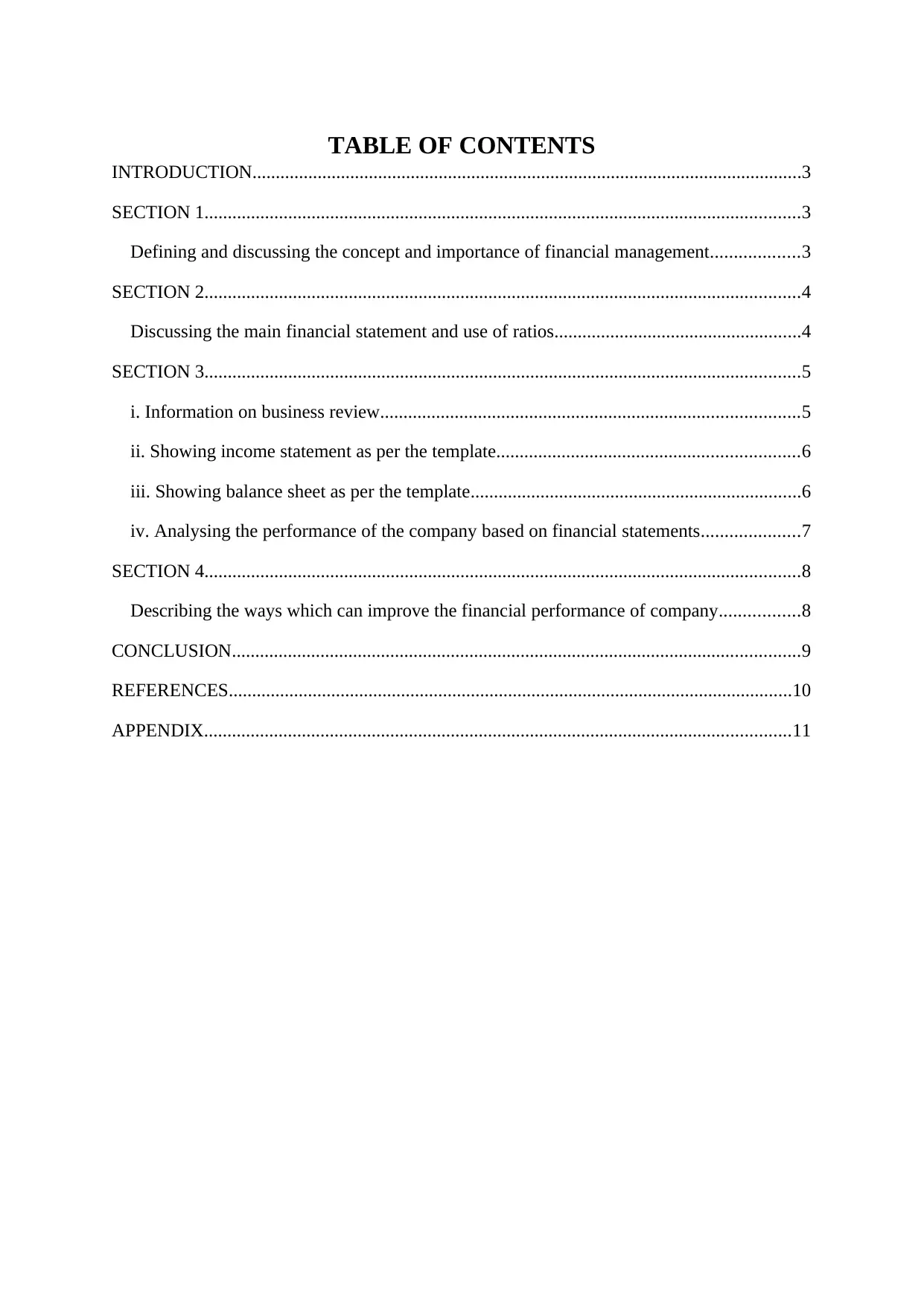
TABLE OF CONTENTS
INTRODUCTION......................................................................................................................3
SECTION 1................................................................................................................................3
Defining and discussing the concept and importance of financial management...................3
SECTION 2................................................................................................................................4
Discussing the main financial statement and use of ratios.....................................................4
SECTION 3................................................................................................................................5
i. Information on business review..........................................................................................5
ii. Showing income statement as per the template.................................................................6
iii. Showing balance sheet as per the template.......................................................................6
iv. Analysing the performance of the company based on financial statements.....................7
SECTION 4................................................................................................................................8
Describing the ways which can improve the financial performance of company.................8
CONCLUSION..........................................................................................................................9
REFERENCES.........................................................................................................................10
APPENDIX..............................................................................................................................11
INTRODUCTION......................................................................................................................3
SECTION 1................................................................................................................................3
Defining and discussing the concept and importance of financial management...................3
SECTION 2................................................................................................................................4
Discussing the main financial statement and use of ratios.....................................................4
SECTION 3................................................................................................................................5
i. Information on business review..........................................................................................5
ii. Showing income statement as per the template.................................................................6
iii. Showing balance sheet as per the template.......................................................................6
iv. Analysing the performance of the company based on financial statements.....................7
SECTION 4................................................................................................................................8
Describing the ways which can improve the financial performance of company.................8
CONCLUSION..........................................................................................................................9
REFERENCES.........................................................................................................................10
APPENDIX..............................................................................................................................11

INTRODUCTION
The business finance refers to the term which defines the management of the
financial resources of the company leading to meeting with the staged aims and objectives of
the business. Handling and managing of the business finances is important in order to make
sure that everything goes well and is within the budget created by the businesses. This report
presents the concept of financial management and its significance to the business. In addition,
the main financial statements and the use of ratio analysis to the business and the ways of
improving the financial performance and position of the business.
SECTION 1
Defining and discussing the concept and importance of financial management
The financial management is a combination of various managerial functions like the
planning, organising, directing, controlling resources of the business entity. And therefore, it
is a crucial part of every business to effectively manage it with ultimate care. The
requirement of the fund is mainly due to the reason of expanding the business or the product
category, improving the operational capacity of the business, making an investment and so
forth. The extent of management of the financial resources is wide as it is concerned about
the various areas such as securing of the accounts, appropriate usage of these monetary
assets, dealing with its customary stock, keeping up the liquidity and dividend choices to
fulfil the expectations of the shareholders (Kostel and Samoilikova, 2019). There are various
other decisions which are being undertaken under the concept of financial management. The
obtaining of funds must be done in a compelling way where the sources of acquiring money
to be utilized keeps up the legitimate balance of debt and equity funds within the capital
structure, limits the risks and boosts the profits for the organization and the least expensive
sources should be applied so the expenses of such procurement can be controlled. Therefore,
it is important to note that proper balance is maintained among the debt and equity funds
which results into both dilution of ownership and the fixed financial burden for the company
is under control.
In addition to this, the company is required to effectively analyse the investment
proposals available by using the investment appraisal tools which helps in determining the
feasibility of it. Along with that, the working capital related decisions are being undertaken
which helps in ensuring smooth conduct of the business which results into enhancing the
credibility along with improved liquidity position of the business (Gallo and et.al., 2018). The
financial management work is huge for the organization in creating performance and future
The business finance refers to the term which defines the management of the
financial resources of the company leading to meeting with the staged aims and objectives of
the business. Handling and managing of the business finances is important in order to make
sure that everything goes well and is within the budget created by the businesses. This report
presents the concept of financial management and its significance to the business. In addition,
the main financial statements and the use of ratio analysis to the business and the ways of
improving the financial performance and position of the business.
SECTION 1
Defining and discussing the concept and importance of financial management
The financial management is a combination of various managerial functions like the
planning, organising, directing, controlling resources of the business entity. And therefore, it
is a crucial part of every business to effectively manage it with ultimate care. The
requirement of the fund is mainly due to the reason of expanding the business or the product
category, improving the operational capacity of the business, making an investment and so
forth. The extent of management of the financial resources is wide as it is concerned about
the various areas such as securing of the accounts, appropriate usage of these monetary
assets, dealing with its customary stock, keeping up the liquidity and dividend choices to
fulfil the expectations of the shareholders (Kostel and Samoilikova, 2019). There are various
other decisions which are being undertaken under the concept of financial management. The
obtaining of funds must be done in a compelling way where the sources of acquiring money
to be utilized keeps up the legitimate balance of debt and equity funds within the capital
structure, limits the risks and boosts the profits for the organization and the least expensive
sources should be applied so the expenses of such procurement can be controlled. Therefore,
it is important to note that proper balance is maintained among the debt and equity funds
which results into both dilution of ownership and the fixed financial burden for the company
is under control.
In addition to this, the company is required to effectively analyse the investment
proposals available by using the investment appraisal tools which helps in determining the
feasibility of it. Along with that, the working capital related decisions are being undertaken
which helps in ensuring smooth conduct of the business which results into enhancing the
credibility along with improved liquidity position of the business (Gallo and et.al., 2018). The
financial management work is huge for the organization in creating performance and future
⊘ This is a preview!⊘
Do you want full access?
Subscribe today to unlock all pages.

Trusted by 1+ million students worldwide
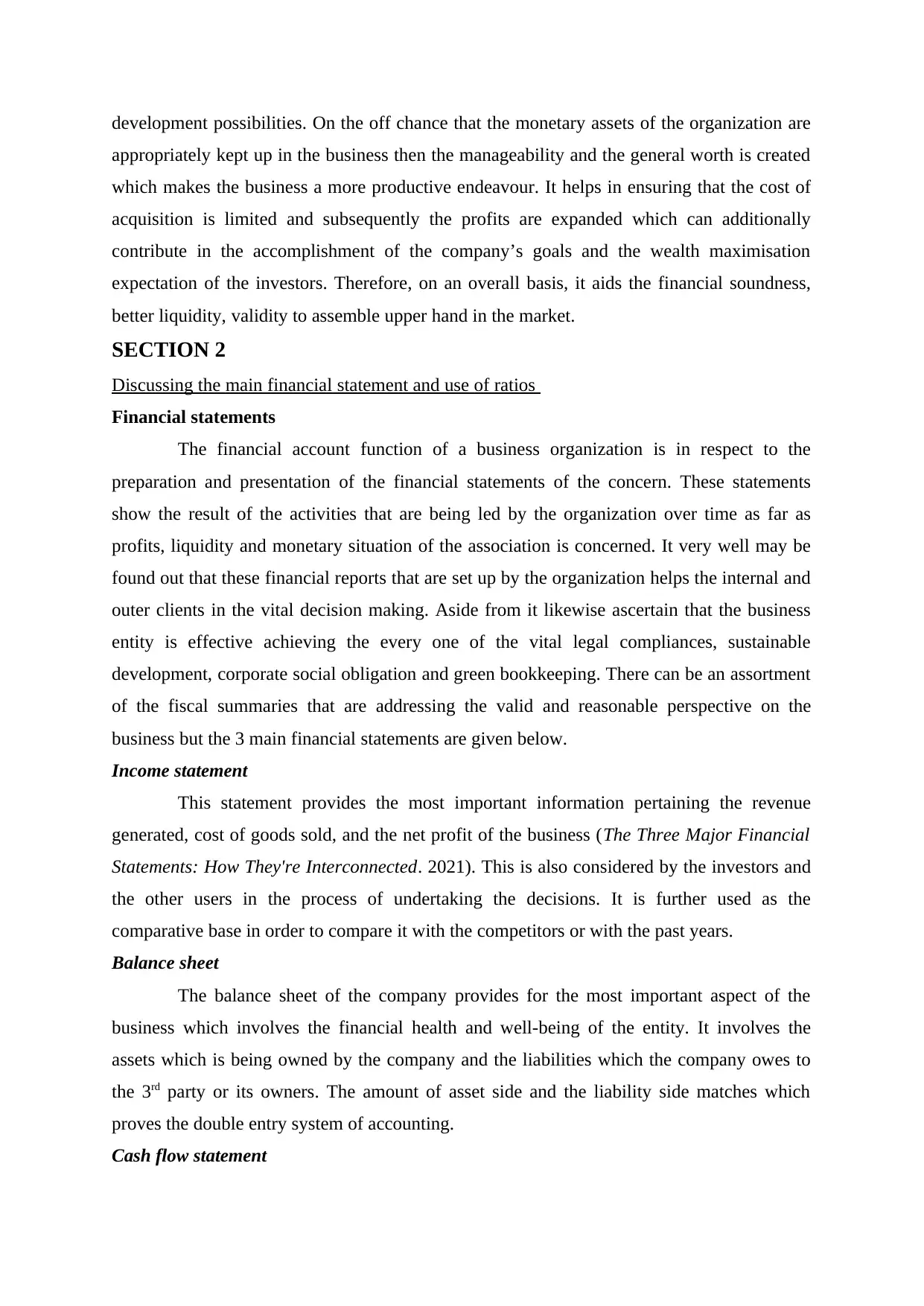
development possibilities. On the off chance that the monetary assets of the organization are
appropriately kept up in the business then the manageability and the general worth is created
which makes the business a more productive endeavour. It helps in ensuring that the cost of
acquisition is limited and subsequently the profits are expanded which can additionally
contribute in the accomplishment of the company’s goals and the wealth maximisation
expectation of the investors. Therefore, on an overall basis, it aids the financial soundness,
better liquidity, validity to assemble upper hand in the market.
SECTION 2
Discussing the main financial statement and use of ratios
Financial statements
The financial account function of a business organization is in respect to the
preparation and presentation of the financial statements of the concern. These statements
show the result of the activities that are being led by the organization over time as far as
profits, liquidity and monetary situation of the association is concerned. It very well may be
found out that these financial reports that are set up by the organization helps the internal and
outer clients in the vital decision making. Aside from it likewise ascertain that the business
entity is effective achieving the every one of the vital legal compliances, sustainable
development, corporate social obligation and green bookkeeping. There can be an assortment
of the fiscal summaries that are addressing the valid and reasonable perspective on the
business but the 3 main financial statements are given below.
Income statement
This statement provides the most important information pertaining the revenue
generated, cost of goods sold, and the net profit of the business (The Three Major Financial
Statements: How They're Interconnected. 2021). This is also considered by the investors and
the other users in the process of undertaking the decisions. It is further used as the
comparative base in order to compare it with the competitors or with the past years.
Balance sheet
The balance sheet of the company provides for the most important aspect of the
business which involves the financial health and well-being of the entity. It involves the
assets which is being owned by the company and the liabilities which the company owes to
the 3rd party or its owners. The amount of asset side and the liability side matches which
proves the double entry system of accounting.
Cash flow statement
appropriately kept up in the business then the manageability and the general worth is created
which makes the business a more productive endeavour. It helps in ensuring that the cost of
acquisition is limited and subsequently the profits are expanded which can additionally
contribute in the accomplishment of the company’s goals and the wealth maximisation
expectation of the investors. Therefore, on an overall basis, it aids the financial soundness,
better liquidity, validity to assemble upper hand in the market.
SECTION 2
Discussing the main financial statement and use of ratios
Financial statements
The financial account function of a business organization is in respect to the
preparation and presentation of the financial statements of the concern. These statements
show the result of the activities that are being led by the organization over time as far as
profits, liquidity and monetary situation of the association is concerned. It very well may be
found out that these financial reports that are set up by the organization helps the internal and
outer clients in the vital decision making. Aside from it likewise ascertain that the business
entity is effective achieving the every one of the vital legal compliances, sustainable
development, corporate social obligation and green bookkeeping. There can be an assortment
of the fiscal summaries that are addressing the valid and reasonable perspective on the
business but the 3 main financial statements are given below.
Income statement
This statement provides the most important information pertaining the revenue
generated, cost of goods sold, and the net profit of the business (The Three Major Financial
Statements: How They're Interconnected. 2021). This is also considered by the investors and
the other users in the process of undertaking the decisions. It is further used as the
comparative base in order to compare it with the competitors or with the past years.
Balance sheet
The balance sheet of the company provides for the most important aspect of the
business which involves the financial health and well-being of the entity. It involves the
assets which is being owned by the company and the liabilities which the company owes to
the 3rd party or its owners. The amount of asset side and the liability side matches which
proves the double entry system of accounting.
Cash flow statement
Paraphrase This Document
Need a fresh take? Get an instant paraphrase of this document with our AI Paraphraser

This statement of the organization provides an insight into the movement of the cash
from and to the business based upon the daily business activities. It provides the information
about the liquidity position of the company pertaining to its ability to business to meet with
its short-term business liabilities. In addition to this, it determines the credibility of the
business in respect to repayment to the third party.
Use of ratios in financial management
The usage of financial ratio analysis is intended to evaluate the monetary
presentation and decide the monetary situation of an association through assessing its profits,
liquidity, debt obligation and other significant pointers. There are numerous groups and
people with different and clashing interests yet need to think about the business execution or
position. The ratio analysis helps in undertaking various decisions and also there is no
meaningful conclusion can be drawn out from it until and unless, more specific information
in relation to it is being provided or gathered (Gullett, Kilgore and Geddie, 2018). But it helps
in determining the areas of strength and weaknesses which is needed to be accounted for
leading to undertake more specific and crucial business decisions. Along with that, it also
assists in the process of forecasting and planning so that meaningful conclusions can be
drawn and is accounts for while making the policies. Apart from this, it supports in exercising
control over the business activities, cost and expenditure, capital outlay, production capacity
etc. It helps in making a comparison with the past results or the expected outcomes set and
based upon which relevant decisions can be undertaken pertaining to determining the reason
for the deviation and implementing the corrective actions for reducing the variance.
SECTION 3
i. Information on business review
2016
£’000
Turnover (continuing operations) 188,000
Profit for the financial year 91000
Shareholder’s equity 117,400
Current assets as % of current liabilities 146 %
Gross Profit for the year 2016 = Sales - COGS
= 188000 -74500 = £113500
from and to the business based upon the daily business activities. It provides the information
about the liquidity position of the company pertaining to its ability to business to meet with
its short-term business liabilities. In addition to this, it determines the credibility of the
business in respect to repayment to the third party.
Use of ratios in financial management
The usage of financial ratio analysis is intended to evaluate the monetary
presentation and decide the monetary situation of an association through assessing its profits,
liquidity, debt obligation and other significant pointers. There are numerous groups and
people with different and clashing interests yet need to think about the business execution or
position. The ratio analysis helps in undertaking various decisions and also there is no
meaningful conclusion can be drawn out from it until and unless, more specific information
in relation to it is being provided or gathered (Gullett, Kilgore and Geddie, 2018). But it helps
in determining the areas of strength and weaknesses which is needed to be accounted for
leading to undertake more specific and crucial business decisions. Along with that, it also
assists in the process of forecasting and planning so that meaningful conclusions can be
drawn and is accounts for while making the policies. Apart from this, it supports in exercising
control over the business activities, cost and expenditure, capital outlay, production capacity
etc. It helps in making a comparison with the past results or the expected outcomes set and
based upon which relevant decisions can be undertaken pertaining to determining the reason
for the deviation and implementing the corrective actions for reducing the variance.
SECTION 3
i. Information on business review
2016
£’000
Turnover (continuing operations) 188,000
Profit for the financial year 91000
Shareholder’s equity 117,400
Current assets as % of current liabilities 146 %
Gross Profit for the year 2016 = Sales - COGS
= 188000 -74500 = £113500
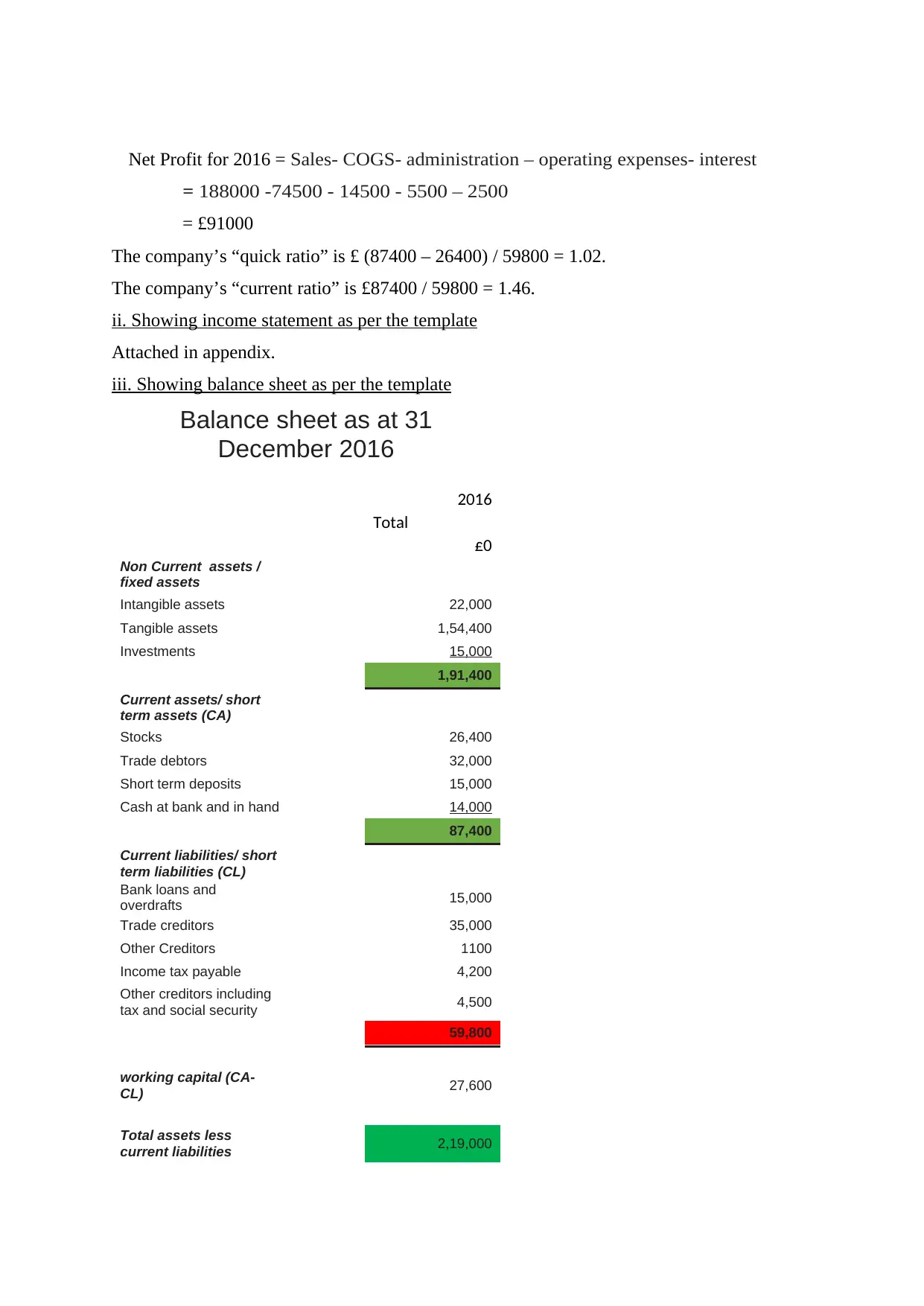
Net Profit for 2016 = Sales- COGS- administration – operating expenses- interest
= 188000 -74500 - 14500 - 5500 – 2500
= £91000
The company’s “quick ratio” is £ (87400 – 26400) / 59800 = 1.02.
The company’s “current ratio” is £87400 / 59800 = 1.46.
ii. Showing income statement as per the template
Attached in appendix.
iii. Showing balance sheet as per the template
Balance sheet as at 31
December 2016
2016
Total
£0
Non Current assets /
fixed assets
Intangible assets 22,000
Tangible assets 1,54,400
Investments 15,000
1,91,400
Current assets/ short
term assets (CA)
Stocks 26,400
Trade debtors 32,000
Short term deposits 15,000
Cash at bank and in hand 14,000
87,400
Current liabilities/ short
term liabilities (CL)
Bank loans and
overdrafts 15,000
Trade creditors 35,000
Other Creditors 1100
Income tax payable 4,200
Other creditors including
tax and social security 4,500
59,800
working capital (CA-
CL) 27,600
Total assets less
current liabilities 2,19,000
= 188000 -74500 - 14500 - 5500 – 2500
= £91000
The company’s “quick ratio” is £ (87400 – 26400) / 59800 = 1.02.
The company’s “current ratio” is £87400 / 59800 = 1.46.
ii. Showing income statement as per the template
Attached in appendix.
iii. Showing balance sheet as per the template
Balance sheet as at 31
December 2016
2016
Total
£0
Non Current assets /
fixed assets
Intangible assets 22,000
Tangible assets 1,54,400
Investments 15,000
1,91,400
Current assets/ short
term assets (CA)
Stocks 26,400
Trade debtors 32,000
Short term deposits 15,000
Cash at bank and in hand 14,000
87,400
Current liabilities/ short
term liabilities (CL)
Bank loans and
overdrafts 15,000
Trade creditors 35,000
Other Creditors 1100
Income tax payable 4,200
Other creditors including
tax and social security 4,500
59,800
working capital (CA-
CL) 27,600
Total assets less
current liabilities 2,19,000
⊘ This is a preview!⊘
Do you want full access?
Subscribe today to unlock all pages.

Trusted by 1+ million students worldwide
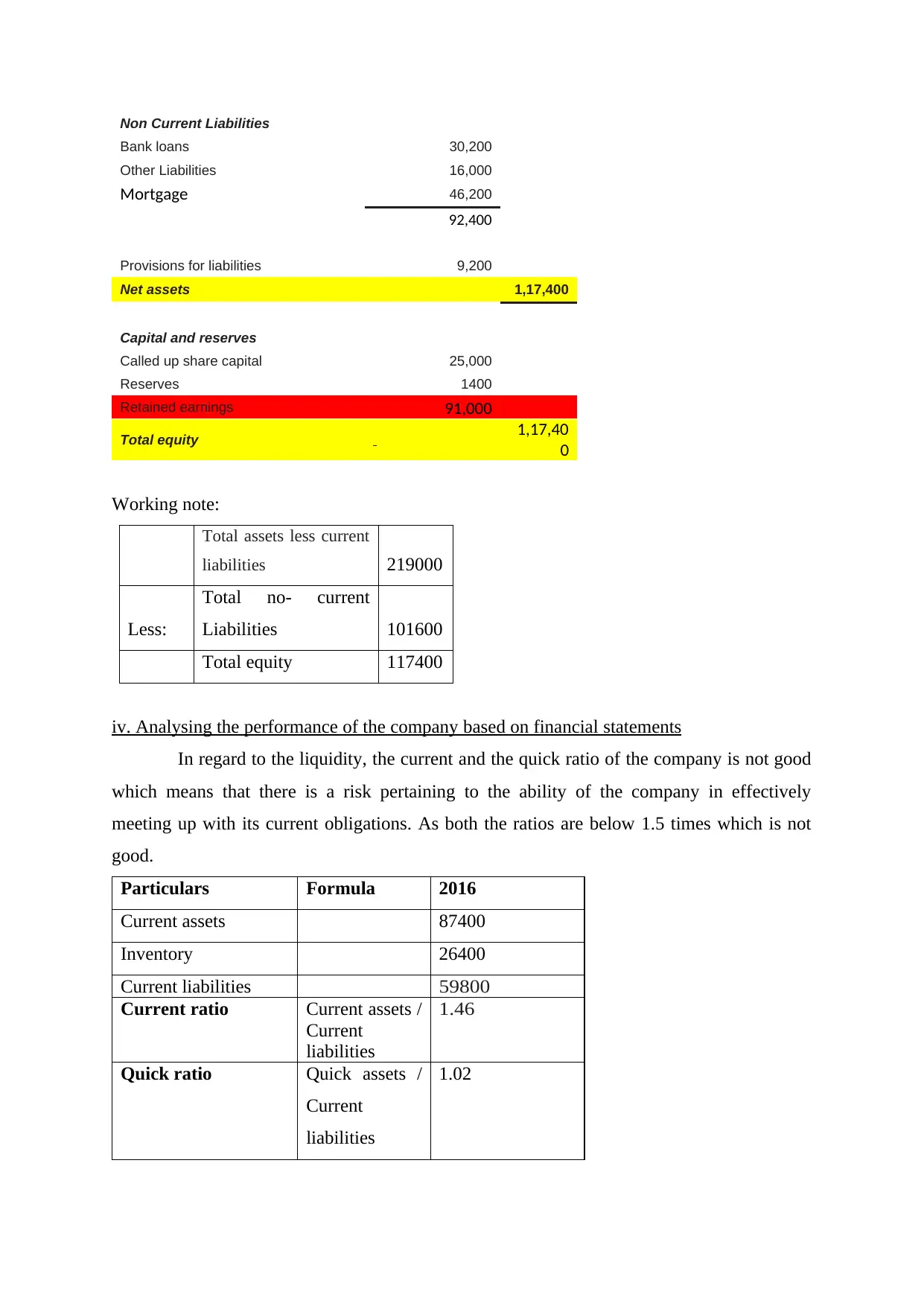
Non Current Liabilities
Bank loans 30,200
Other Liabilities 16,000
Mortgage 46,200
92,400
Provisions for liabilities 9,200
Net assets 1,17,400
Capital and reserves
Called up share capital 25,000
Reserves 1400
Retained earnings 91,000
Total equity 1,17,40
0
Working note:
Total assets less current
liabilities 219000
Less:
Total no- current
Liabilities 101600
Total equity 117400
iv. Analysing the performance of the company based on financial statements
In regard to the liquidity, the current and the quick ratio of the company is not good
which means that there is a risk pertaining to the ability of the company in effectively
meeting up with its current obligations. As both the ratios are below 1.5 times which is not
good.
Particulars Formula 2016
Current assets 87400
Inventory 26400
Current liabilities 59800
Current ratio Current assets /
Current
liabilities
1.46
Quick ratio Quick assets /
Current
liabilities
1.02
Bank loans 30,200
Other Liabilities 16,000
Mortgage 46,200
92,400
Provisions for liabilities 9,200
Net assets 1,17,400
Capital and reserves
Called up share capital 25,000
Reserves 1400
Retained earnings 91,000
Total equity 1,17,40
0
Working note:
Total assets less current
liabilities 219000
Less:
Total no- current
Liabilities 101600
Total equity 117400
iv. Analysing the performance of the company based on financial statements
In regard to the liquidity, the current and the quick ratio of the company is not good
which means that there is a risk pertaining to the ability of the company in effectively
meeting up with its current obligations. As both the ratios are below 1.5 times which is not
good.
Particulars Formula 2016
Current assets 87400
Inventory 26400
Current liabilities 59800
Current ratio Current assets /
Current
liabilities
1.46
Quick ratio Quick assets /
Current
liabilities
1.02
Paraphrase This Document
Need a fresh take? Get an instant paraphrase of this document with our AI Paraphraser
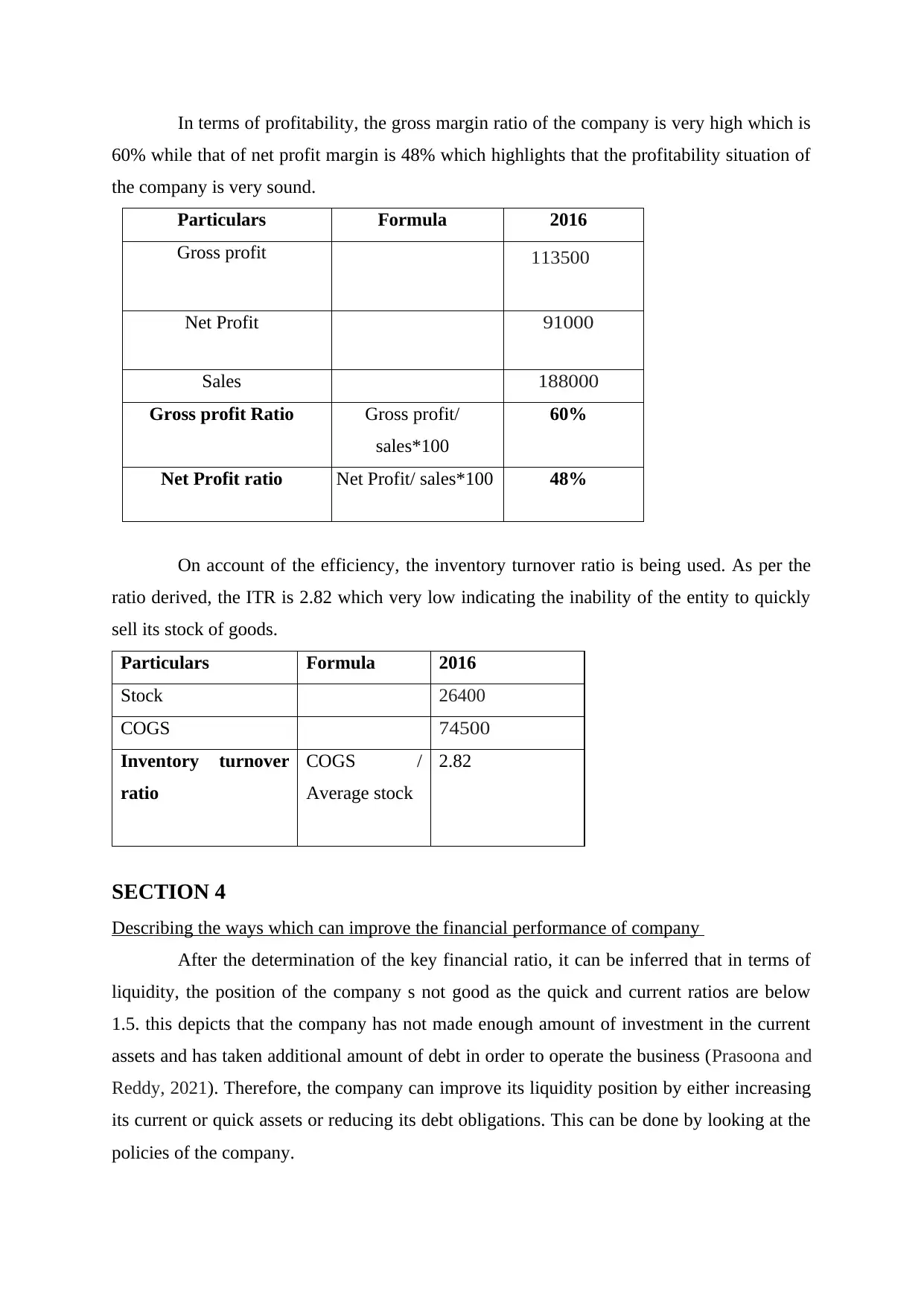
In terms of profitability, the gross margin ratio of the company is very high which is
60% while that of net profit margin is 48% which highlights that the profitability situation of
the company is very sound.
Particulars Formula 2016
Gross profit 113500
Net Profit 91000
Sales 188000
Gross profit Ratio Gross profit/
sales*100
60%
Net Profit ratio Net Profit/ sales*100 48%
On account of the efficiency, the inventory turnover ratio is being used. As per the
ratio derived, the ITR is 2.82 which very low indicating the inability of the entity to quickly
sell its stock of goods.
Particulars Formula 2016
Stock 26400
COGS 74500
Inventory turnover
ratio
COGS /
Average stock
2.82
SECTION 4
Describing the ways which can improve the financial performance of company
After the determination of the key financial ratio, it can be inferred that in terms of
liquidity, the position of the company s not good as the quick and current ratios are below
1.5. this depicts that the company has not made enough amount of investment in the current
assets and has taken additional amount of debt in order to operate the business (Prasoona and
Reddy, 2021). Therefore, the company can improve its liquidity position by either increasing
its current or quick assets or reducing its debt obligations. This can be done by looking at the
policies of the company.
60% while that of net profit margin is 48% which highlights that the profitability situation of
the company is very sound.
Particulars Formula 2016
Gross profit 113500
Net Profit 91000
Sales 188000
Gross profit Ratio Gross profit/
sales*100
60%
Net Profit ratio Net Profit/ sales*100 48%
On account of the efficiency, the inventory turnover ratio is being used. As per the
ratio derived, the ITR is 2.82 which very low indicating the inability of the entity to quickly
sell its stock of goods.
Particulars Formula 2016
Stock 26400
COGS 74500
Inventory turnover
ratio
COGS /
Average stock
2.82
SECTION 4
Describing the ways which can improve the financial performance of company
After the determination of the key financial ratio, it can be inferred that in terms of
liquidity, the position of the company s not good as the quick and current ratios are below
1.5. this depicts that the company has not made enough amount of investment in the current
assets and has taken additional amount of debt in order to operate the business (Prasoona and
Reddy, 2021). Therefore, the company can improve its liquidity position by either increasing
its current or quick assets or reducing its debt obligations. This can be done by looking at the
policies of the company.
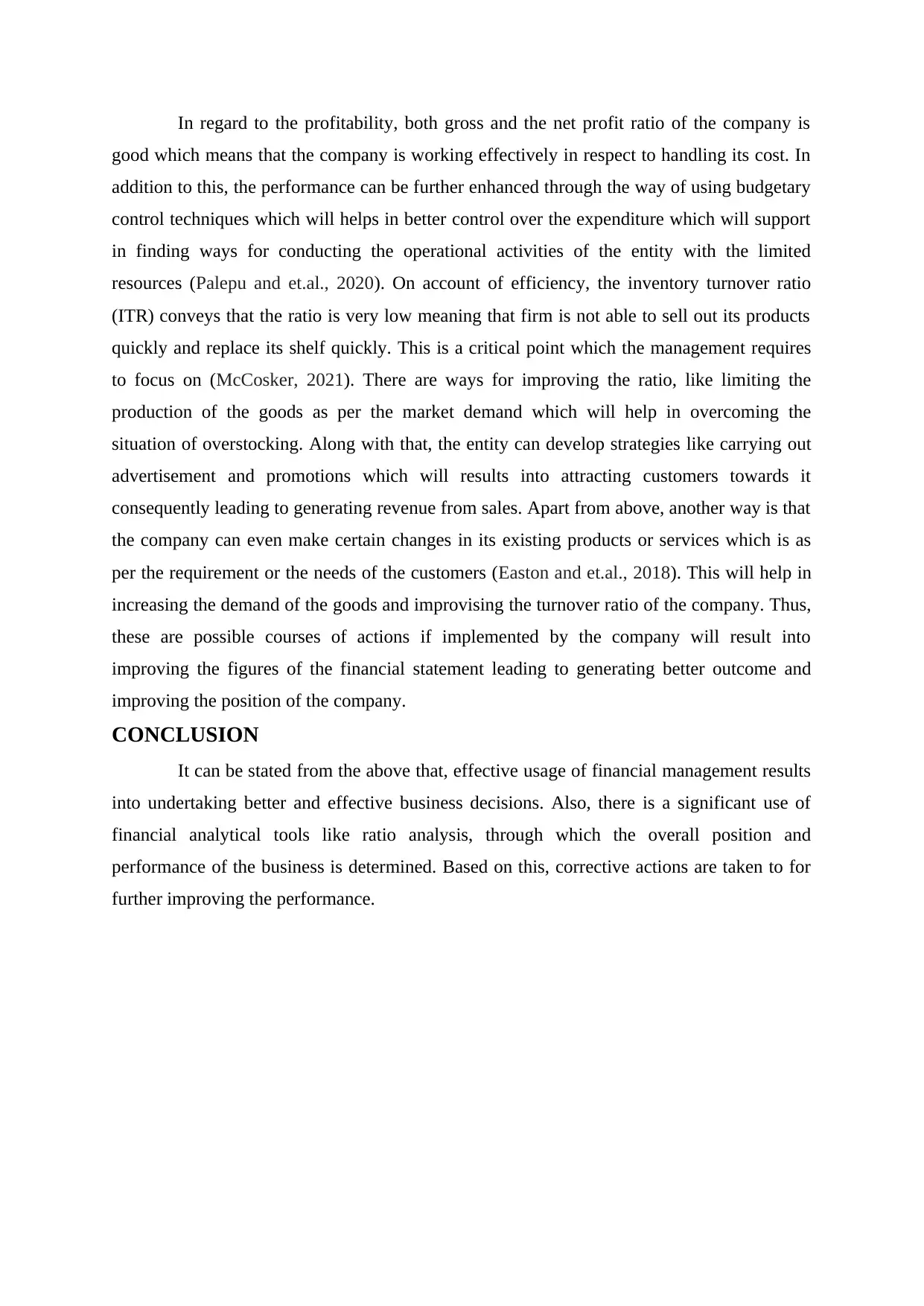
In regard to the profitability, both gross and the net profit ratio of the company is
good which means that the company is working effectively in respect to handling its cost. In
addition to this, the performance can be further enhanced through the way of using budgetary
control techniques which will helps in better control over the expenditure which will support
in finding ways for conducting the operational activities of the entity with the limited
resources (Palepu and et.al., 2020). On account of efficiency, the inventory turnover ratio
(ITR) conveys that the ratio is very low meaning that firm is not able to sell out its products
quickly and replace its shelf quickly. This is a critical point which the management requires
to focus on (McCosker, 2021). There are ways for improving the ratio, like limiting the
production of the goods as per the market demand which will help in overcoming the
situation of overstocking. Along with that, the entity can develop strategies like carrying out
advertisement and promotions which will results into attracting customers towards it
consequently leading to generating revenue from sales. Apart from above, another way is that
the company can even make certain changes in its existing products or services which is as
per the requirement or the needs of the customers (Easton and et.al., 2018). This will help in
increasing the demand of the goods and improvising the turnover ratio of the company. Thus,
these are possible courses of actions if implemented by the company will result into
improving the figures of the financial statement leading to generating better outcome and
improving the position of the company.
CONCLUSION
It can be stated from the above that, effective usage of financial management results
into undertaking better and effective business decisions. Also, there is a significant use of
financial analytical tools like ratio analysis, through which the overall position and
performance of the business is determined. Based on this, corrective actions are taken to for
further improving the performance.
good which means that the company is working effectively in respect to handling its cost. In
addition to this, the performance can be further enhanced through the way of using budgetary
control techniques which will helps in better control over the expenditure which will support
in finding ways for conducting the operational activities of the entity with the limited
resources (Palepu and et.al., 2020). On account of efficiency, the inventory turnover ratio
(ITR) conveys that the ratio is very low meaning that firm is not able to sell out its products
quickly and replace its shelf quickly. This is a critical point which the management requires
to focus on (McCosker, 2021). There are ways for improving the ratio, like limiting the
production of the goods as per the market demand which will help in overcoming the
situation of overstocking. Along with that, the entity can develop strategies like carrying out
advertisement and promotions which will results into attracting customers towards it
consequently leading to generating revenue from sales. Apart from above, another way is that
the company can even make certain changes in its existing products or services which is as
per the requirement or the needs of the customers (Easton and et.al., 2018). This will help in
increasing the demand of the goods and improvising the turnover ratio of the company. Thus,
these are possible courses of actions if implemented by the company will result into
improving the figures of the financial statement leading to generating better outcome and
improving the position of the company.
CONCLUSION
It can be stated from the above that, effective usage of financial management results
into undertaking better and effective business decisions. Also, there is a significant use of
financial analytical tools like ratio analysis, through which the overall position and
performance of the business is determined. Based on this, corrective actions are taken to for
further improving the performance.
⊘ This is a preview!⊘
Do you want full access?
Subscribe today to unlock all pages.

Trusted by 1+ million students worldwide
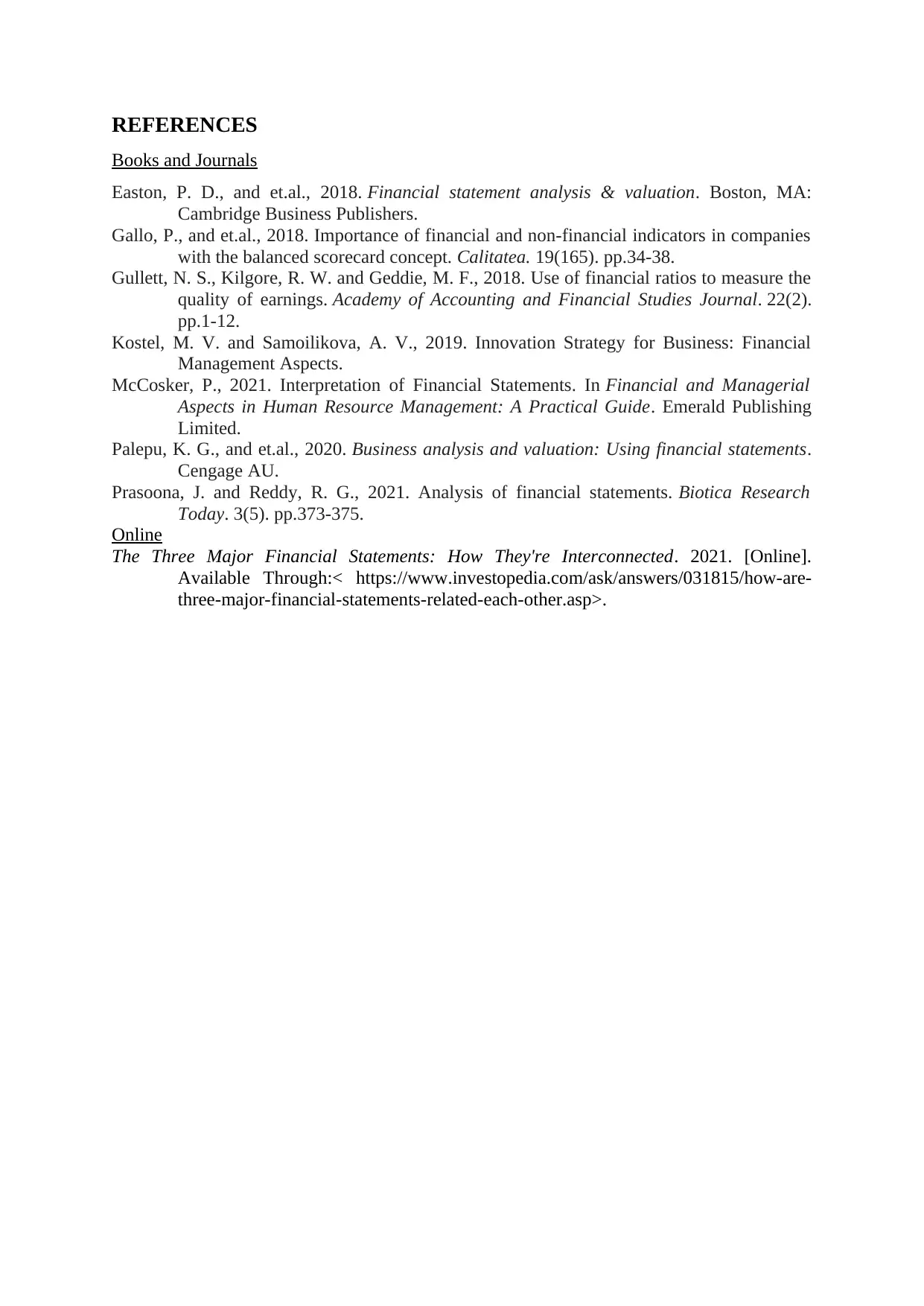
REFERENCES
Books and Journals
Easton, P. D., and et.al., 2018. Financial statement analysis & valuation. Boston, MA:
Cambridge Business Publishers.
Gallo, P., and et.al., 2018. Importance of financial and non-financial indicators in companies
with the balanced scorecard concept. Calitatea. 19(165). pp.34-38.
Gullett, N. S., Kilgore, R. W. and Geddie, M. F., 2018. Use of financial ratios to measure the
quality of earnings. Academy of Accounting and Financial Studies Journal. 22(2).
pp.1-12.
Kostel, M. V. and Samoilikova, A. V., 2019. Innovation Strategy for Business: Financial
Management Aspects.
McCosker, P., 2021. Interpretation of Financial Statements. In Financial and Managerial
Aspects in Human Resource Management: A Practical Guide. Emerald Publishing
Limited.
Palepu, K. G., and et.al., 2020. Business analysis and valuation: Using financial statements.
Cengage AU.
Prasoona, J. and Reddy, R. G., 2021. Analysis of financial statements. Biotica Research
Today. 3(5). pp.373-375.
Online
The Three Major Financial Statements: How They're Interconnected. 2021. [Online].
Available Through:< https://www.investopedia.com/ask/answers/031815/how-are-
three-major-financial-statements-related-each-other.asp>.
Books and Journals
Easton, P. D., and et.al., 2018. Financial statement analysis & valuation. Boston, MA:
Cambridge Business Publishers.
Gallo, P., and et.al., 2018. Importance of financial and non-financial indicators in companies
with the balanced scorecard concept. Calitatea. 19(165). pp.34-38.
Gullett, N. S., Kilgore, R. W. and Geddie, M. F., 2018. Use of financial ratios to measure the
quality of earnings. Academy of Accounting and Financial Studies Journal. 22(2).
pp.1-12.
Kostel, M. V. and Samoilikova, A. V., 2019. Innovation Strategy for Business: Financial
Management Aspects.
McCosker, P., 2021. Interpretation of Financial Statements. In Financial and Managerial
Aspects in Human Resource Management: A Practical Guide. Emerald Publishing
Limited.
Palepu, K. G., and et.al., 2020. Business analysis and valuation: Using financial statements.
Cengage AU.
Prasoona, J. and Reddy, R. G., 2021. Analysis of financial statements. Biotica Research
Today. 3(5). pp.373-375.
Online
The Three Major Financial Statements: How They're Interconnected. 2021. [Online].
Available Through:< https://www.investopedia.com/ask/answers/031815/how-are-
three-major-financial-statements-related-each-other.asp>.
Paraphrase This Document
Need a fresh take? Get an instant paraphrase of this document with our AI Paraphraser
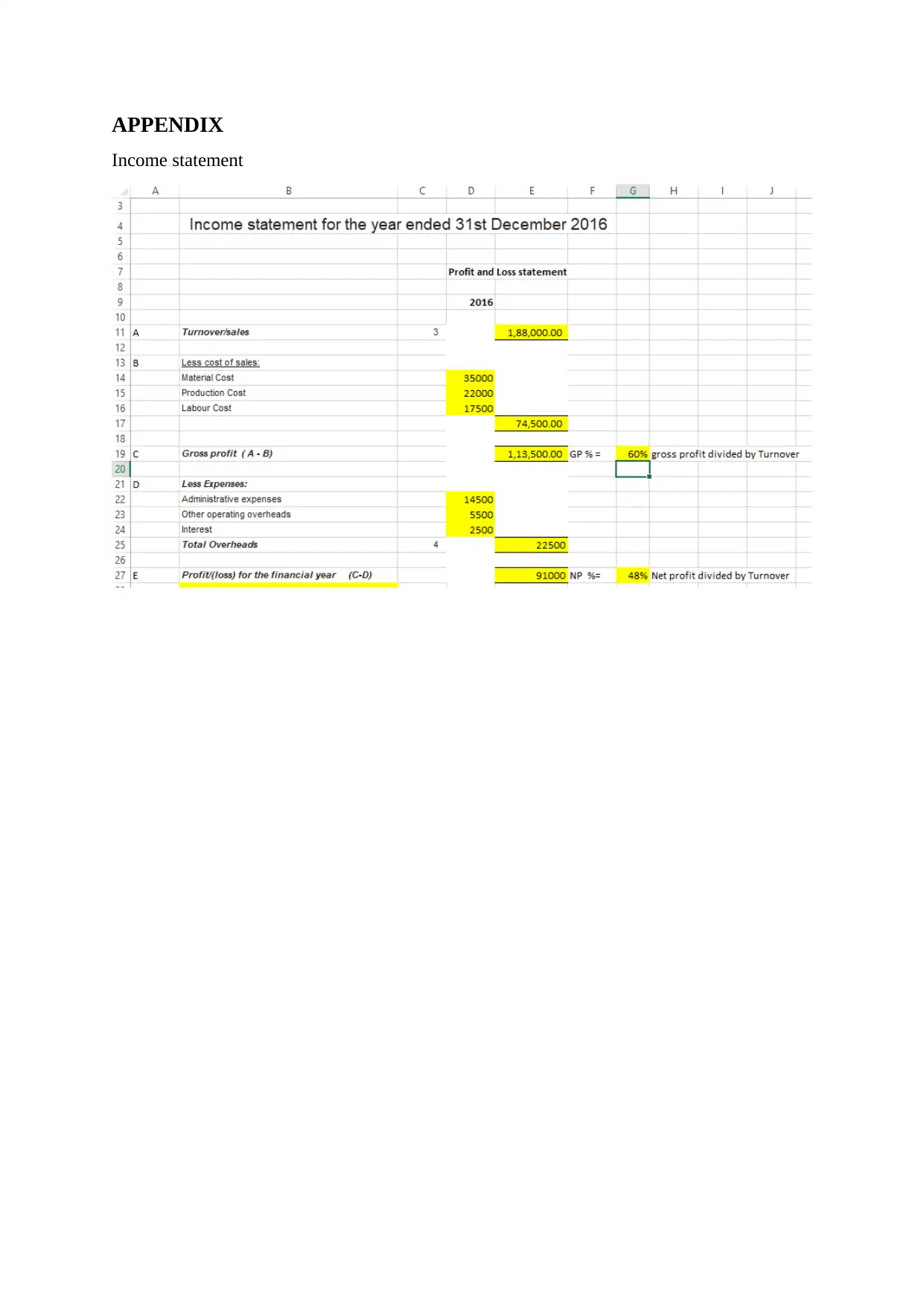
APPENDIX
Income statement
Income statement
1 out of 11
Related Documents
Your All-in-One AI-Powered Toolkit for Academic Success.
+13062052269
info@desklib.com
Available 24*7 on WhatsApp / Email
![[object Object]](/_next/static/media/star-bottom.7253800d.svg)
Unlock your academic potential
Copyright © 2020–2025 A2Z Services. All Rights Reserved. Developed and managed by ZUCOL.




